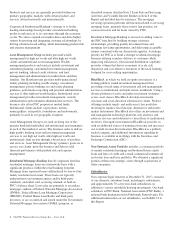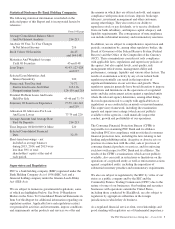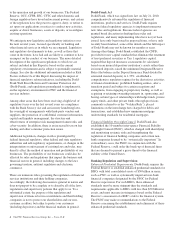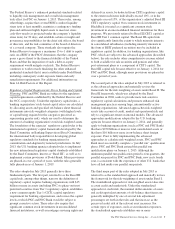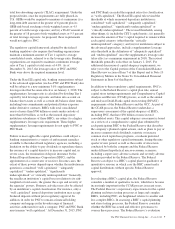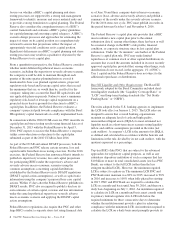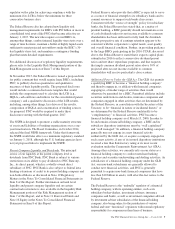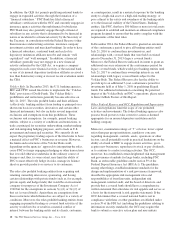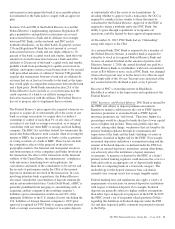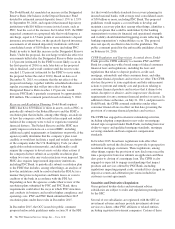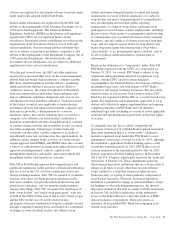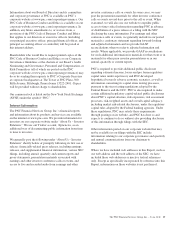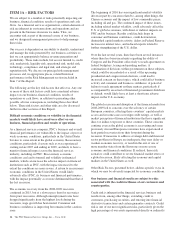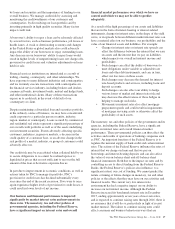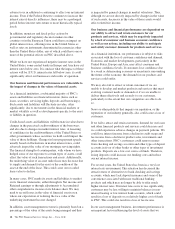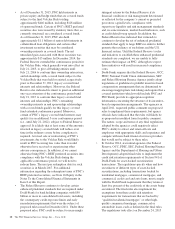PNC Bank 2015 Annual Report Download - page 28
Download and view the complete annual report
Please find page 28 of the 2015 PNC Bank annual report below. You can navigate through the pages in the report by either clicking on the pages listed below, or by using the keyword search tool below to find specific information within the annual report.
In addition, the GLB Act permits qualifying national banks to
engage in expanded activities through the formation of a
“financial subsidiary.” PNC Bank has filed a financial
subsidiary certification with the OCC and currently engages in
insurance agency activities through financial subsidiaries.
PNC Bank may also generally engage through a financial
subsidiary in any activity that is determined to be financial in
nature or incidental to a financial activity by the Secretary of
the Treasury, in consultation with the Federal Reserve (other
than insurance underwriting activities, insurance company
investment activities and merchant banking). In order to have
a financial subsidiary, a national bank and each of its
depository institution affiliates must be and remain “well
capitalized” and “well managed.” In addition, a financial
subsidiary generally may not engage in a new financial
activity authorized by the GLB Act, or acquire a company
engaged in such a new financial activity, if the national bank
or any of its insured depository institution affiliates received a
less than Satisfactory rating at its most recent evaluation under
the CRA.
Volcker Rule. In December 2013, the U.S. banking agencies,
SEC and CFTC issued final rules to implement the “Volcker
Rule” provisions of Dodd-Frank. The Volcker Rule’s
prohibitions and restrictions generally became effective on
July 21, 2015. The rules prohibit banks and their affiliates
(collectively, banking entities) from trading as principal on a
short-term basis in securities, derivatives and certain other
financial instruments, but also includes several important
exclusions and exemptions from this prohibition. These
exclusions and exemptions, for example, permit banking
entities, subject to a variety of conditions and restrictions, to
trade as principal for securities underwriting, market making
and risk-mitigating hedging purposes, and to trade in U.S.
government and municipal securities. We currently do not
expect the proprietary trading aspects of the final rules to have
a material effect on PNC’s businesses or revenue. However,
the limits and restrictions of the Volcker Rule could,
depending on the agencies’ approach to interpreting the rules,
cause PNC to forego engaging in hedging or other transactions
that it would otherwise undertake in the ordinary course of
business and, thus, to some extent, may limit the ability of
PNC to most effectively hedge its risks, manage its balance
sheet or provide products or services to its customers.
The rules also prohibit banking entities from acquiring and
retaining ownership interests in, sponsoring, and having
certain relationships with private funds (such as, for example,
private equity and hedge funds) that would be an investment
company for purposes of the Investment Company Act of
1940 but for the exemptions in sections 3(c)(1) or 3(c)(7) of
that act (covered funds). Again there are exemptions from
these restrictions which themselves are subject to a variety of
conditions. Moreover, the rules prohibit banking entities from
engaging in permitted trading or covered fund activities if the
activity would involve or result in a material conflict of
interest between the banking entity and its clients, customers,
or counterparties, result in a material exposure by the banking
entity to a high-risk asset or a high-risk trading strategy, or
pose a threat to the safety and soundness of the banking entity
or to the financial stability of the United States. Banking
entities, like PNC, that have $50 billion or more in total assets
are required to establish and maintain an enhanced compliance
program designed to ensure that the entity complies with the
requirements of the final rules.
In December 2014, the Federal Reserve granted an extension
of the conformance period to give all banking entities until
July 21, 2016 to conform their investments in, and
relationships with, covered funds that were held or existed
prior to December 31, 2013 (legacy covered funds).
Moreover, the Federal Reserve indicated its intent to grant an
additional one-year extension of the conformance period for
legacy covered funds, which would give banking entities until
July 21, 2017 to conform their ownership interests in, and
relationships with, legacy covered funds subject to the
Volcker Rule. The Federal Reserve also has the ability to
provide up to an additional 5-year conformance period for
investments held as of May 1, 2010 in qualifying illiquid
funds. For additional information concerning the potential
impact of the Volcker Rule on PNC’s operations, please refer
to Item 1A Risk Factors of this Report.
Other Federal Reserve and OCC Regulation and Supervision.
Laws and regulations limit the scope of our permitted
activities and investments. The federal banking agencies also
possess broad powers to take corrective action as deemed
appropriate for an insured depository institution and its
holding company.
Moreover, examination ratings of “3” or lower, lower capital
ratios than peer group institutions, regulatory concerns
regarding management, controls, assets, operations or other
factors, can all potentially result in practical limitations on the
ability of a bank or BHC to engage in new activities, grow,
acquire new businesses, repurchase its stock or pay dividends,
or to continue to conduct existing activities. The OCC,
moreover, has established certain heightened risk management
and governance standards for large banks, including PNC
Bank, as enforceable guidelines under section 39 of the
Federal Deposit Insurance Act (FDI Act). The guidelines,
among other things, establish minimum standards for the
design and implementation of a risk governance framework,
describe the appropriate risk management roles and
responsibilities of front line units, independent risk
management, internal audit, and the board of directors, and
provide that a covered bank should have a comprehensive
written statement that articulates its risk appetite and serves as
a basis for the framework (a risk appetite statement). If the
OCC determines that a covered national bank is not in
compliance with these or other guidelines established under
section 39 of the FDI Act (including the guidelines relating to
information security standards), the OCC may require the
bank to submit a corrective action plan and may initiate
10 The PNC Financial Services Group, Inc. – Form 10-K




